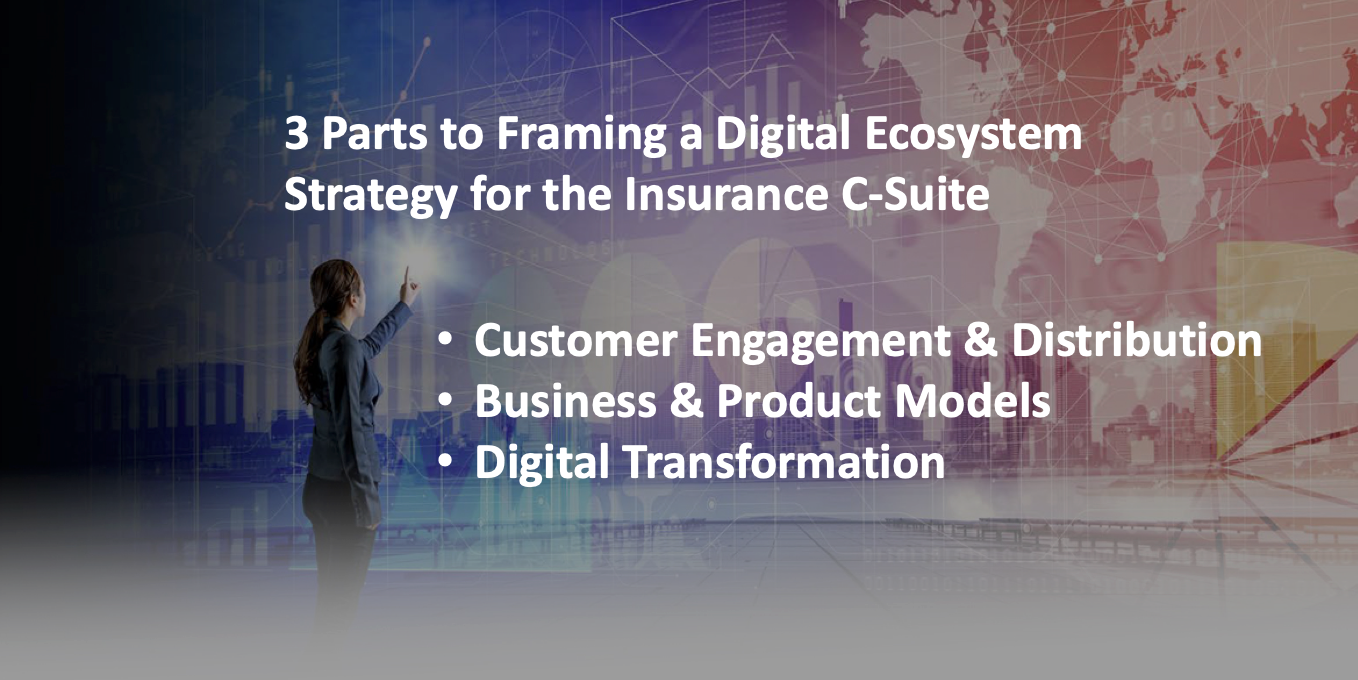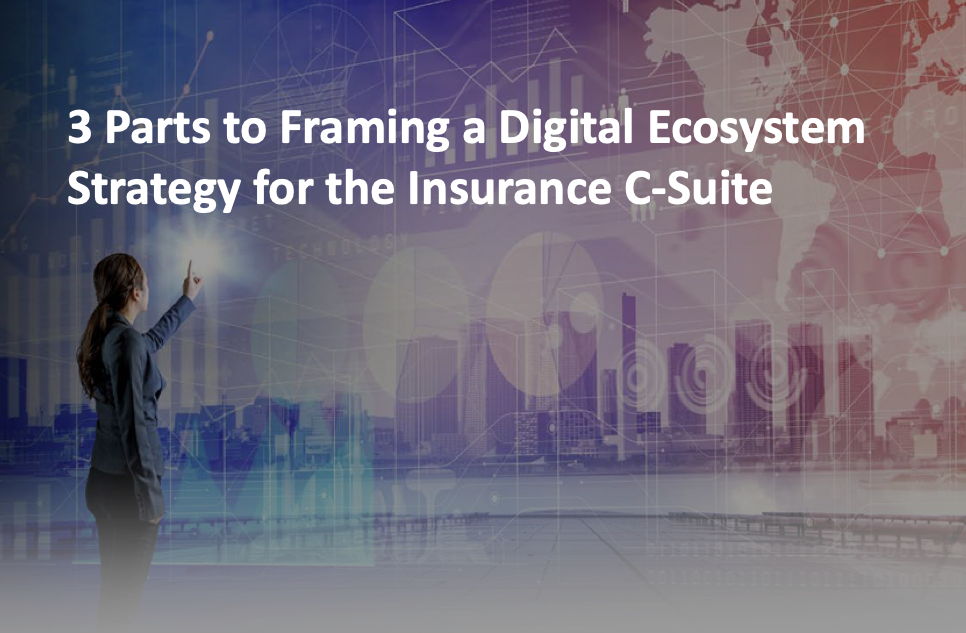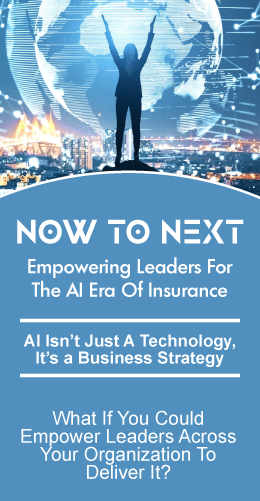
If you’re responsible for strategy, innovation or digital transformation you are likely getting an increasing number of questions from C-Suite Executives about Digital Ecosystems. For most insurance companies, the concept of digital ecosystems remains vague. Its something between a buzzword and examples like Google, Apple, and occasionally Ping An, the Chinese insurance giant. These examples provide little in terms of actionable insight that enable executives to redefine priorities or reallocate resources. A simple explanation of what digital ecosystems are and breaking your strategy into 3 parts will.
Digital Ecosystems will dramatically change the insurance industry.
They offer innovators everything from new avenues to advertise and engage customers, to embedded insurance plays, to partnerships that support value-added services as part of an insurance offering. They also offer companies in and outside of the industry the ability to develop platforms and even entire ecosystems to support customer lifestyles or breakthrough efficiencies for core insurance processes. They and the solutions within them are maturing and growing in size and influence at a rapid rate. So the question is how do we communicate the importance of developing a comprehensive digital ecosystem strategy now to execs so they can shift priorities and resources appropriately.
We and the execs we support need a strategic framework. A framework that fosters a clearer understanding of digital ecosystems, one that guides exploration, assessment, and investment. This 3 part framework will be easy for them to digest. The three parts are, Customer Engagement and Distribution, Product and Business Models, and Digital Transformation.
Start by integrating the concept of Digital Ecosystems Into Initiatives that are already underway.
he easiest way to get a new concept or program going at most large companies is to tie it to something the company has already established as a priority. The most logical places are the company’s initiatives in Customer Engagement and Distribution, New Business and Product Models, and Digital Transformation.
Start with a simple explanation of digital ecosystems.
Digital ecosystems are an integrated collection of digital devices, solutions, processes and infrastructure. Digital ecosystems have many different functions and serve the needs of many different audiences. Those include things that are important to insurance customers like wealth management, wellness, transportation, and business management.
The need for a digital ecosystem strategy.
Individual, as well as business insurance customers increasingly use digital devices and solutions to help them achieve their goals. More and more of those devices and solutions are cloud-based. And, more and more of them are integrating with other solutions to enable users to more holistically address their needs. As the ecosystems and platforms within them gain traction, more and more similar solution providers join them. This provides an increasing number of options to the end customer. As those providers partner and compete, the ecosystem becomes a marketplace. A market place that is innovating, growing and creating new solutions at digital speeds.
These ecosystems hold deep data about customers, their interests, behaviors, activities, and connections. Information that enables solution providers to create and deliver highly personalized messaging, solutions, and incentives. Like any other network, certain participants and platforms will rise to the top in terms of the number of connections they have and the value they create. Relationships with those top-level players will be highly competed for by others who want to leverage their access and influence in the market. Insurers that are late developing a strategy and developing active partnering relationships within the ecosystems that create the most value for specific customer segments will have a difficult time building a sustainable position in those ecosystems.
Where are Digital Ecosystems Forming
Digital Ecosystems are forming around customer lifestyles, purchasing habits, and life goals. They are also forming around businesses and industries. They provide highly effective access to customers, partners who trust them. They provide the kind of user experience and the ability to holistically address needs that customers are increasingly demanding.
Additionally they are forming within and around insurance. InsurTechs and Tech vendors are developing cloud-based solutions to support insurance customers, insurers, and the distribution partners that serve them. They are gathering and analyzing data from multiple sources ranging from medical to vehicle, to home and factory information and packaging to support customer engagement, underwriting, and claims. They are also forming partnerships and offering platforms that make it easier for insurers to bring to market new products and business models. The net effect is that they are making it far easier and more cost-effective for insurers to develop and sell solutions that meet the needs of today’s digitally oriented customers.
It is for these reasons that insurers need to act now to integrate digital ecosystem strategies into their overall corporate plans and initiatives. Coming late to the digital ecosystem game really isn’t an option.
Framing a digital ecosystem strategy for the C-Suite.
Once you’ve built an understanding of what digital ecosystems are and their impact, the next question is, “where do we start?” You don’t want to give them a boil the ocean strategy. Instead, give them the ability to integrate Digital Ecosystems into initiatives that are already underway.
Part 1. Customer Engagement & Distribution
Customer Engagement
Integrating digital ecosystems into your customer engagement strategy will have several layers. The first is identifying which digital ecosystems your customers using that are most closely aligned with risks you are interested in insuring. You can get started with simple promotional programs and advertising. The next step is identifying the behaviors and actions prospective or existing customers take within the ecosystem that gives you the opportunity to engage and provide value in terms of information or options that would help them better achieve their goals and reduce their risks.
Distribution
The next layer is identifying potential distribution partners. Partners that can actually extend an offer and transact business. Identify the partners that align with the risks and that have a strong and trusted relationship with the customer. Develop a support program that ensures the end customer and the distribution partner have the information they need to interact effectively with each other.
Intelligent Customer Journey
The rich data that flows within and even across digital ecosystems provides a treasure trove of insights into the customer. Use that information to develop and intelligently support the customer journey. That information can be used to build their awareness of risk/need all the way to onboarding and supporting their changing needs. As part of intelligent journey enablement, make sure that the customer can share their data as needed with other partners such as agents or brokers or other services providers.
By leveraging the digital ecosystem and its resources, you can develop a customer engagement and distribution strategy that increases your access and insight to customers as their life or business needs change. With that insight and access, you can deliver differentiating value to them at the various points of their journey by providing the appropriate content or person to person support. Making sure that the journey and information are seamlessly integrated is key. Customers don’t like to repeat themselves or start from scratch to explain their needs and situation.
Part 2. Product and Business Models
Product and business models for digital ecosystems can run from simple to complex. The simplest take advantage of devices such as fit bits or telematics data. They provide incentives to support things like a healthy lifestyle or good driving. Solutions that step up a level may incorporate relationships with other services. In the case of life and health, that could include fitness center programs or discounts or rewards for purchasing healthy foods. In the case of driving, it could include relationships with roadside services, pre-negotiated rates on replacement vehicles and much more. Parametric insurance offerings that are triggered based on data from 3rd party data or sensors are also an option. There are already products on the market for risks like floods or crop damage. Embedded insurance offerings can be integrated into the purchase of a product or service. Insurance as part of a product purchase for small items like tools, musical instruments, or even large items like autos are already on the market. More complex offerings can be composed from multiple services such as those that track and monitor supply lines, or that tie into smart home infrastructure and appliances.
Platform-based business models can be developed to support and drive revenue from the services and offerings that run it. As an example a platform to support the homeowner in the life cycle of purchasing and maintaining a home. The platform could provide home insurance, contents, and liabilities associated with homeownership. It could offer 3rd party services for home maintenance and protection as well as variable insurance based on the family or guest occupancy as the family group ages. 3rd parties could also offer alternative mortgage options based on the owner’s life status. Ecosystems can have multiple platforms within them.
Ecosystem Orchestrator models are the most complex of business models. Examples of this include Ping An in China. They have build and manage an ecosystem that supports health, wealth management and banking, and insurance. Building and managing ecosystems will most likely be done by the largest companies. They could include partnerships between companies like Amazon ad Munich Re as an example.
The options for creating digital ecosystem enabled products and business models are unlimited. The key to developing a strategy is to stay focused on where you can create the greatest customer value. Two important things to consider are which of your traditional lines of business are most at risk to competitors that leverage digital ecosystems to deliver more compelling solutions, and which emerging high growth areas could you bring the greatest value to. The other major consideration is what your internal strengths and weaknesses are from a cultural, resource, and infrastructure standpoint. Examining these objectively is critical. You may also find that partnerships with others are critical to implementing any of these strategies.
Part 3. Digital Transformation
Digital Transformation is the last piece of the Digital Ecosystem Framework. Sustainable Digital Transformation programs are designed holistically to support a company in staying competitive as the world and its industry are continually redefined by emerging technology and the innovation it enables. The programs include upgrading and enhancing the companies processes and infrastructure as well as building a more innovative and agile culture.
Integrating digital ecosystems into your digital transformation strategy is the next logical step in making sure your company is ready for the digital future. For insurance companies that includes evaluating how they can leverage the digital capabilities and ecosystems being formed by InsurTechs and Technology Vendors as well as the digital ecosystems surrounding the customers to improve their core processes and infrastructure.
InsurTechs and the more innovative Tech Vendors that serve the insurance industry are working individually and in partnership to develop interoperable microservices and API’s. The tech vendors are deploying architectures designed as platforms that make it much easier for 3rd parties to interoperate within them. They are building digital partnerships with InsurTech and others based on those platforms. This makes it easier for insurers who use their platforms to build and deploy next-generation products and processes that leverage 3rd party services and solutions. Additionally, large players like LLoyds and Re-insurers are also building out digital platforms. Those digital capabilities are providing the raw material for a Digital Ecosystem for Insurance. As this ecosystem matures, insurers that leverage it will find it easier and easier to deploy new products and continually optimize their core processes.
Digital ecosystem surrounding insureds provide rich data sets. Those data sets can provide real-time data about the activities, behaviors, environment, context, and risks the insured or the insured property is operating within. Tapping into those provides deep information that enables insurers information that will help identify, assess and price risk, recommend or change policy structure, and assist in evaluating and processing claims more effectively. Leveraging these provides the insurers who do the competitive upper hand in terms of internal efficiencies, customer experience, and operating profits.
To leverage the advantages digital ecosystems provide requires internal policies, processes, and systems that can interoperate within them. Designing and building an enterprise architecture and systems that support that must become a central part of your digital transformation strategy.
We’ve covered three parts of Digital Ecosystem Strategy. Customer Engagement and Distribution, Product and Business Models, and Digital Transformation. Almost every insurance company is working on at least 2 of those areas. Integrating the concept of Digital Ecosystems to those is just a logical next step and a natural extension of work already underway.
Interdependencies
As you outline requirements and opportunities in each of the 3 areas, it will be clear that there are interdependencies among them. Interdependencies that are a requirement as well as those that when addressed can create significant returns in terms of customer value, experience, and or operational efficiencies. Selecting the right digital ecosystem partners will be critical to make addressing those as easy as possible. You will want partners that see and are building toward this bigger picture. You will also want to select partners who have or will have the ability to build and sustain a powerful value-added position within the ecosystems they are a part of. The same applies to your company. You have to have the corporate willingness and wherewithal to be the kind of partner you want your partners to be.
Digital Ecosystems are complex. Developing a corporate digital ecosystem strategy won’t be easy. However, breaking it down into component parts, and integrating it as a logical next step to the initiatives you already have underway can make it much easier to understand and support for executives and the stakeholders that have to implement.
Your thoughts and input appreciated.








